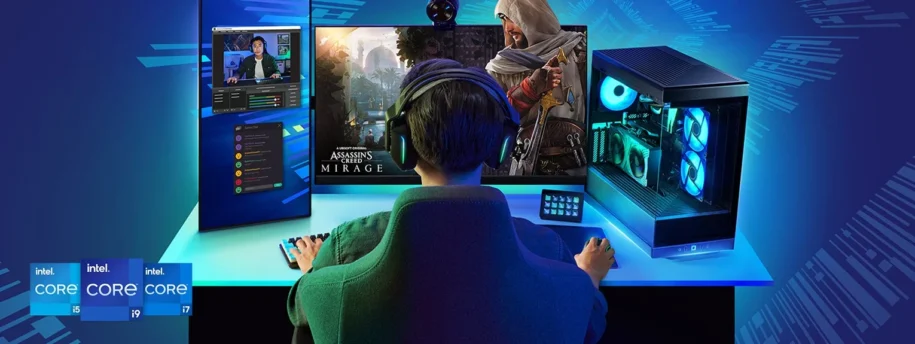
Your CPU plays a pivotal role in ensuring smooth gameplay, faster load times, and an overall immersive experience. For gamers running Intel processors, there are several ways to optimize your CPU for maximum performance. In this guide, we’ll walk you through the best methods to boost your Intel CPU performance for a better gaming experience.
Table of Contents
1. Overclocking Your Intel CPU
Overclocking is the bread and butter of getting better performance out of your CPU. Overclocking allows you to push your processor beyond its factory-set speeds, potentially delivering higher frame rates and better game performance. Intel’s “K” series processors are particularly suited for overclocking, thanks to their unlocked multipliers.
Steps to Overclock:
- Use Intel Extreme Tuning Utility (XTU): Intel provides an excellent software solution for tweaking your CPU’s performance settings. The Intel XTU tool allows you to adjust voltages, CPU core multipliers, and monitor thermal performance. Learn more about overclocking your Intel CPU from team Blue themselves here.
- Overclock directly from the BIOS: If you are a more advanced user this provides the most granular control over your overclocking.
- Monitor Stability: Overclocking can push your system to the limit, so stability testing is crucial. After making changes, run stress tests such as Prime95 or AIDA64 to ensure your system remains stable during intensive gaming sessions.
- Keep an Eye on Temperatures: Overclocking generates additional heat. Use high-quality thermal paste and ensure that your cooling system—whether it’s air or liquid—is up to the task. Tools like HWMonitor can help you keep track of temperatures in real time. If your system looks a bit too hot than you you’ll want to upgrade your cooling system.
2. Upgrade Your Cooling Solution
A cooler CPU is a faster CPU. Keeping your Intel processor cool will not only help with overclocking but also ensure long-term performance by preventing thermal throttling.
Cooling Options:
- Air Coolers: For most mid-range gaming setups, a high-performance air cooler will suffice. Look for models with large heat sinks and multiple heat pipes to dissipate heat effectively.
- Liquid Cooling: If you want to push your CPU further or overclock it heavily, liquid cooling might be the way to go. All-in-one (AIO) liquid coolers are a popular choice for gamers seeking efficient and quieter cooling solutions.
3. Update Your BIOS and Drivers
Outdated BIOS and drivers can be a potential bottleneck for your Intel CPU’s performance. Regularly updating them ensures your CPU is working with the latest optimizations and bug fixes.
How to Update BIOS:
- Visit your motherboard manufacturer’s website and download the latest BIOS version.
- Follow the provided instructions, which often involve using a USB drive and your system’s BIOS interface.
Driver Updates:
- Intel’s Drivers: Ensure you have the latest chipset and CPU drivers installed. Intel provides regular updates that can improve stability and performance, especially for new games.
- GPU Drivers: While focusing on the CPU is key, don’t forget to keep your GPU drivers updated, as they work in tandem with your processor to deliver smooth gaming experiences.
4. Adjust Power Settings
To maximize CPU performance, it’s crucial to configure your system’s power settings. By default, some systems might throttle the CPU to conserve power, which can hurt gaming performance. Let’s get things set up correctly
Power Plan Adjustments in Windows:
- Go to the Control Panel > Power Options, and select the High-Performance power plan. This ensures that your CPU will always operate at its maximum potential during gaming.
- For advanced users, head into the Advanced Power Settings to customize CPU settings further, like setting the minimum processor state to 100%.
5. Optimize Your In-Game Settings
Sometimes, boosting your CPU’s performance doesn’t require technical adjustments but rather optimizing your in-game settings. Some games are more CPU-intensive than others, and tweaking certain settings can free up CPU resources.
Recommended Settings:
- Lower Shadows ,View Distance , and NPC density: Shadows and draw distance heavily rely on the CPU. Reducing these settings can significantly improve performance without sacrificing too much visual quality. NPC or crowd density (if the game has that option) is another area you can tune things down
- Limit Background Applications: When gaming, make sure no other applications are hogging your CPU’s resources. Use Task Manager to close unnecessary programs and background tasks.
6. Consider CPU Upgrades
If you’re still experiencing performance issues despite trying these methods, it might be time to consider upgrading your Intel processor. Intel’s newer generations of CPUs, such as 14th generation Intel core processors, offer significant improvements in both single-core and multi-core performance, essential for today’s demanding games.
Maximizing your Intel CPU’s gaming performance can lead to smoother gameplay, higher frame rates, and an overall better gaming experience. By employing the strategies outlined above you can help you unlock your system’s full potential. And if you’re looking for the best gaming setup, consider exploring our range of Intel based gaming computers, designed to deliver top-tier performance right out of the box.
Take things to the next level by improving the performance of your Intel CPU!